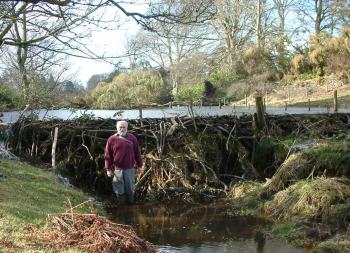The Salmon and Trout Association (S&TA), Britain’s leading gamefish conservation body, is warning that a recently published comprehensive survey of Atlantic salmon rivers in one province of eastern Canada has concluded that beavers can have a major adverse impact on fish populations. The warning comes on the eve of the release of beavers into the wild in Knapdale, Argyll.
The report entitled “A Conservation Strategy for Atlantic Salmon in Prince Edward Island”, which was commissioned by the Atlantic Salmon Federation (North America’s main salmon conservation organisation), states that salmon habitat on the island has been “seriously compromised by two primary limiting factors” – one of which is beavers. Their dams “prevent salmon from reaching preferred spawning and nursery sites and sometimes prevent young salmon from going to sea”. The report concludes that, unless beavers are removed or culled on an ongoing basis, the result will be “the demise of salmon runs” in at least three of the island’s rivers and will put salmon runs “in jeopardy” in a further seven.
Paul Knight, Executive Director of S&TA, said: “This report is unequivocal in its conclusions and it should be required reading for those who have granted the Knapdale beaver licence. While the American beaver is a different species to its European cousin, both species share a propensity for dam building whenever the available habitat is not to their liking. Beaver dams are of course the problem and on either side of the Atlantic they can amount to insurmountable obstacles to migrating salmon, sea trout and brown trout, particularly when, as is normally the case, there is little depth of water below the dam”.
 Mr Knight added: “Apart from the ten rivers whose salmon populations are currently under threat, the Prince Edward report identifies 11 rivers on the island which have actually lost their salmon populations since 2002. It concludes that ‘beaver blockages appear to be the main reason’. It is worth noting that beavers were re-introduced to Prince Edward Island in 1949 but six decades on it is clear that their impact on salmon numbers has been little short of catastrophic. Surely this must cause alarm bells to ring within Scottish Government. It is vital that proper scientific research is now commissioned into the likely impact of burgeoning beaver numbers on migratory fish populations in Scotland and indeed the rest of Britain. Furthermore there needs to be absolute clarity on what will happen to the Knapdale beavers once the trial period is concluded”.
Mr Knight added: “Apart from the ten rivers whose salmon populations are currently under threat, the Prince Edward report identifies 11 rivers on the island which have actually lost their salmon populations since 2002. It concludes that ‘beaver blockages appear to be the main reason’. It is worth noting that beavers were re-introduced to Prince Edward Island in 1949 but six decades on it is clear that their impact on salmon numbers has been little short of catastrophic. Surely this must cause alarm bells to ring within Scottish Government. It is vital that proper scientific research is now commissioned into the likely impact of burgeoning beaver numbers on migratory fish populations in Scotland and indeed the rest of Britain. Furthermore there needs to be absolute clarity on what will happen to the Knapdale beavers once the trial period is concluded”.
Nick Yonge, Director of the Tweed Foundation, which has campaigned against the Knapdale release, added: “The Prince Edward Island report underlines how stupid it would be to introduce beavers to Britain. Introducing animals that make major changes to our countryside is only acceptable where those changes can be contained effectively to specific areas. The evidence from countries where beavers have been introduced is that they cannot be contained and that they would cause harm to our native fish stocks by building dams. I believe that the Government and their advisors now understand this and I expect it to be reflected in their future plans for species introductions”.
The full Prince Edward Island report may be viewed at http://atlanticsalmonfederation.org/pei/2009peireport.html








